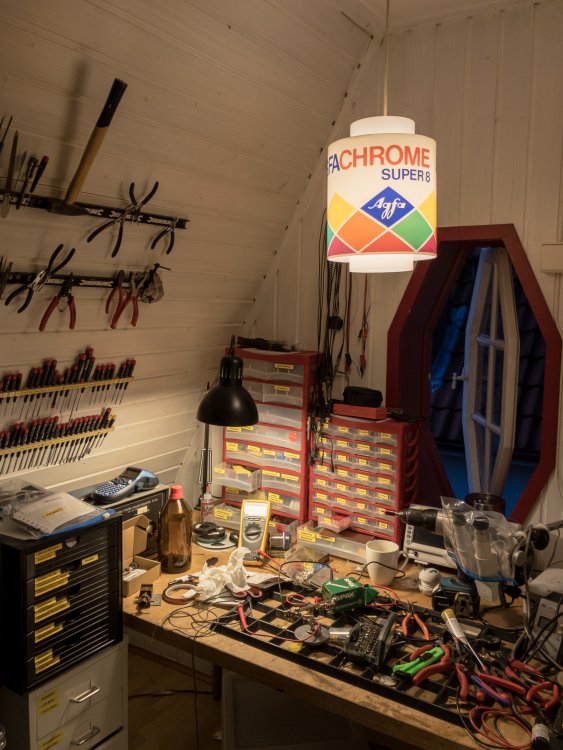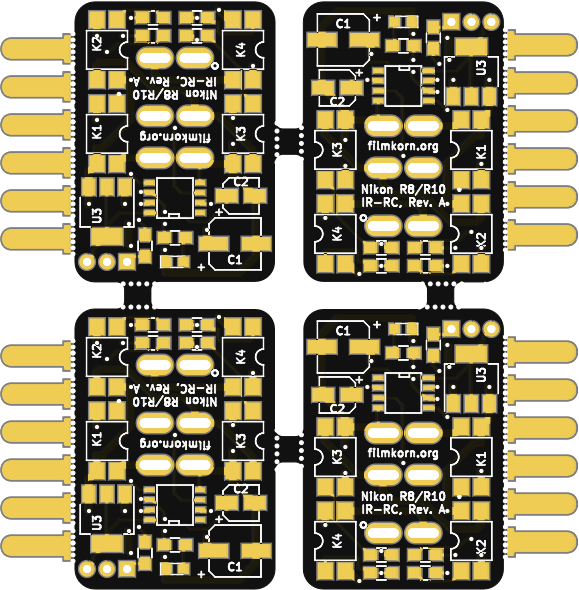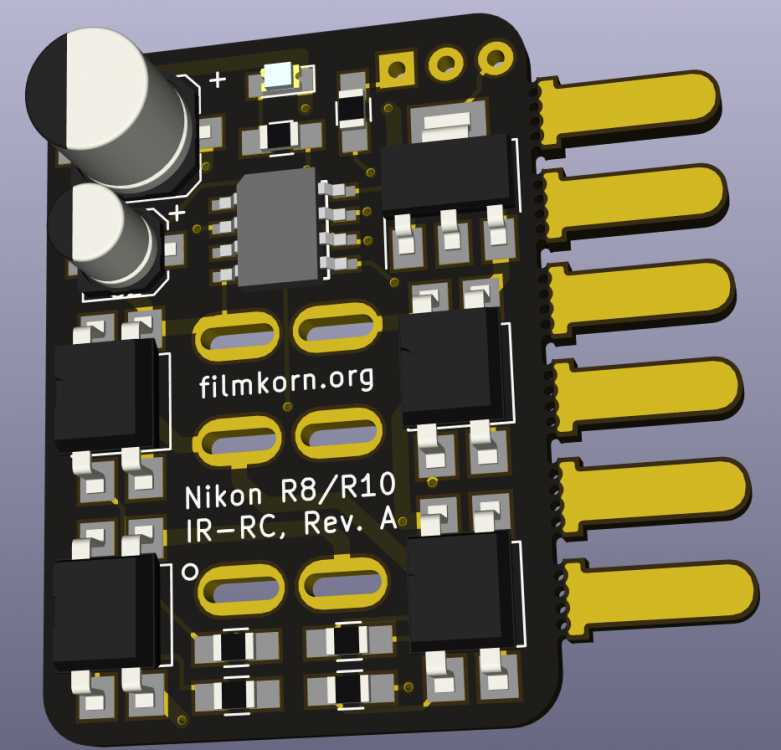-
Gesamte Inhalte
12.853 -
Benutzer seit
-
Letzter Besuch
-
Tagessiege
526
Inhaltstyp
Profile
Forum
Galerie
Alle erstellten Inhalte von Friedemann Wachsmuth
-

Das ultimative Schmalfilmwichteln!
Friedemann Wachsmuth antwortete auf Friedemann Wachsmuth's Thema in Schmalfilm
Ich bin auch wunderbar bewichtelt worden mit zwei wunderbaren, instandsetzungswürdigen Kameras. Vielen Dank, lieber Wichtel! -

Das ultimative Schmalfilmwichteln!
Friedemann Wachsmuth antwortete auf Friedemann Wachsmuth's Thema in Schmalfilm
Ich mach meins definitiv erst Heiligabend auf. Zugfahren ist aber eine Entschuldigung. -

Noris Record L100 transportiert nicht
Friedemann Wachsmuth antwortete auf Kartenkai's Thema in Schmalfilm
Ich fürchte, der Greifer ist abgebrochen oder massiv verbogen. Das ist zumindest kein häufiger Fehler... ist mir in ca, 15 Norissen noch nie untergekommen. :( -

Das ultimative Schmalfilmwichteln!
Friedemann Wachsmuth antwortete auf Friedemann Wachsmuth's Thema in Schmalfilm
Ich hab meins heut auch bekommen. Und absolut keine Ahnung... -

Synkino – endlich einfach vertonen
Friedemann Wachsmuth antwortete auf Friedemann Wachsmuth's Thema in Schmalfilm
Nein, ich habe zwar auch eine A77 hier stehen, aber die wird nicht unterstützt werden. Dafür gibt es ja auch schon Lösungen. Beim Synkino müssen die Dateien als MP3, WMA, M4A, oder OGG auf einer SD-Karte liegen. Das hat den Vorteil, dass die Soundtracks für Hunderte an Filmen alle auf ein Daumennagel-großes Kärtchen passen. :) WAV(E) kann ich nicht unterstützen, da sind zu viele Datenmengen zu wuppen. Das schafft mein System nicht. Braucht man aber auch nicht wirklich. Heut hab ich nach viel Grübeln ein lustiges Phänomen gefunden: Ungenaue Quarze. Von preiswerten Resonatoren bin ich schon länger weg. Aber wenn der Quarz des µC mit 15,9986 MHz (statt 16 MHz) und der des Audio-Players mit 12,2893 (statt 12,2880 MHz) läuft, dann erklärt das, warum nicht exakt 44100 Samples pro "Sekunde" wiedergegeben werden. Die Zeit ist einfach ein zickiges Biest, gerade, wenn man sie mit unterschiedlichen Uhren messen muss... -

Synkino – endlich einfach vertonen
Friedemann Wachsmuth antwortete auf Friedemann Wachsmuth's Thema in Schmalfilm
Das macht Mut. :) Danke. -
März 2013 war es wohl. Geht ja noch :) https://www.kickstarter.com/projects/cappuccino/beyond-the-bolex-a-documentary-film
-
Ach! Ich erinnere mich, vor vielen Jahren (6? 7?) mal so einen Film mitgebackt zu haben. Und dann hab ich nie wieder etwas gehört. Sollte er das jetzt sein? Dann hat es sich gelohnt. :)
-

Synkino – endlich einfach vertonen
Friedemann Wachsmuth antwortete auf Friedemann Wachsmuth's Thema in Schmalfilm
Es ist ein Stück voran gegangen dieser Tage. Den größten Teil der Zeit habe ich gebraucht, um meinen Code vom letzten Jahr zu verstehen. Wer schreibt sowas? Brrr! Jetzt ist es sauberer, übersichtlicher und strukturierter. Und damit einfacher. Den Elektronikteil habe ich auch neu aufgebaut, die Steckbretter waren schon am Zerfallen. Featuremässig habe ich wohl nun endlich alles an der Hand, um ein echtes I in meinem PID-Regler zu haben. Nur wenn das steht und funktioniert, kann es weitergehen, daher muss ich da jetzt erst mal durch. Von RS-485, Bluetooth und RFID-Leser bin ich ab. Lieber (erstmal) einfach halten, es sind auch so noch mehr als genug Baustellen. -
Ich fürchte, das kriegst Du nicht mehr aus der Gelatine. Mit nix. (In Aceton lost sich Triacetat übrigens auf...)
-
Übrigens sitze ich seit gestern wieder man Synkino. Nach einem Jahr den eigenen Code verstehen hat eine Weile gebraucht. Und der Weg ist noch lang. Aber zumindest gehts wieder voran. :) (Aber bitte nicht drauf warten, Thorsten!)
-

Schmalfilmentwicklungsmaschine für Super 8 und 16 mm im Eigenbau
Friedemann Wachsmuth antwortete auf Sandro Proske's Thema in Schmalfilm
Welche ist völlig egal. Wie stellst Du Dir den Tank denn vor? -
Nee, die hat er von mir. :) lag hier schon ewig im Keller.
-
-

Noris Record L100 transportiert nicht
Friedemann Wachsmuth antwortete auf Kartenkai's Thema in Schmalfilm
Welchen “Zapfen” meinst Du? Den Greifer in der Nähe des Bildfensters? -

Ferienzeit ist Bastelzeit
Friedemann Wachsmuth antwortete auf Friedemann Wachsmuth's Thema in Schmalfilm
Oh Danke :) -

Ferienzeit ist Bastelzeit
Friedemann Wachsmuth antwortete auf Friedemann Wachsmuth's Thema in Schmalfilm
Das mache ich selbst. Lohnt bei so kleinen Mengen nicht, Pick&Place einzurichten. -

Ferienzeit ist Bastelzeit
Friedemann Wachsmuth antwortete auf Friedemann Wachsmuth's Thema in Schmalfilm
-

Ferienzeit ist Bastelzeit
Friedemann Wachsmuth antwortete auf Friedemann Wachsmuth's Thema in Schmalfilm
/* ATtiny85 IR Remote Control Receiver This code simulates the Nikon EA-1 Remote Control Switch and adds extra functions, like IR-Remote control support and a nifty intervalometer with 416 different intervals ranging from 200ms to more than 37 hours. The power needed for the circuit is harvested from the camera (the camera connector has no actual power output). Some documentation on the hardware below: Pin numbering, looking onto the camera side jack (or PCB Front) 3 Green - - Brown 4 2 Red - - Yellow 5 space space 1 Blue - - White 6 Inside the handpiece of the remote control: Sliders move from 0 to 1 for lightmeter and from 1 to 2 for exposure. |-------| |---------| |------| 2 expose | | | | |-------|------| | |------| 1 lightmeter on | | | | | | 0 no connect Brown Blue Red Green Yellow White 4 1 2 3 5 6 \ Hold /\ Load /\ Start / \Light/ The "Load" phase charges a capacitor to ease sudden startup and assure even exposure timing. The entire start mechanism of the Nikon R8/R10 is rather sophisticated and barely documented. We need four relays here to follow the protocol. Not following the protocol can work, but might damage the camera... who want's that? */ #include <util/delay.h> // built-in delay() runs too fast due to timer0 usage in IR receiver ISR /* Apple Remote (all models) 87 EE */ // see https://en.wikipedia.org/wiki/Apple_Remote // *** defines and variables *************************** #define RC_CODE 0x87EE // Apple #define UP_KEY 0x05 // Up #define DOWN_KEY 0x06 // Down #define LEFT_KEY 0x04 // Left #define RIGHT_KEY 0x03 // Right #define MENU_KEY 0x01 // Menu #define ALU_CENTER_KEY 0x2E // Center (Alu RC) #define ALU_PLAY_KEY 0x2F // Play (Alu RC) #define WHITE_PLAY_KEY 0x02 // Play (old white Apple Remote) #define LM_MODE_1ST_SINGLESHOT 1 // On the first single exposure shot, we start with lightmetering. #define LM_MODE_SUB_SINGLESHOT 2 // Subsequent shots do not meter the light again. // These are our four relays int lightmeterPin = 3; // K4 ye + wh : Lightmeter int startPin = 4; // K3 re + gr : Start int loadPin = 1; // K2 bl + re : Load int holdPin = 0; // K1 br + bl : Hold int ledPin = 1; // LED is parallel to load-relay volatile int irBits; // This counts the incoming bits from NEC-encoded IR transmitters in the ISR volatile unsigned long receivedData; // This contains the received code // These are used to maintain the different intervals byte oldIntervalStep = 31; // This is the initial OCR1C value (at 1 MHz / Prescaler 16384 = 524ms) byte newIntervalStep = 31; // store it here after a change, since we only update OCR1C in the ISR int postscaler = 2; // the postscaler doubles the timer1 by POT factors up to 2^16 (39:04:20) volatile int divider = 0; // needed in ISR to do some modulo for intervals > 4.3 sec byte lmMode = LM_MODE_1ST_SINGLESHOT; bool blinkFlag = true; // Thisone is used to confirm reception fo valid IR codes bool aluRemote = false; // Apple's Alumium Remote has one more key than the white one. Reading // that key is ambigious, so we "lock in" to a safe mode once we know for sure // that our RC is not the white one. // *** Setup ********************************************** void setup() { pinMode(lightmeterPin, OUTPUT); pinMode(holdPin, OUTPUT); pinMode(loadPin, OUTPUT); pinMode(startPin, OUTPUT); noInterrupts(); // Set up timeStampr/Counter0 (assumes 1MHz clock) TCCR0A = 0; // No compare matches TCCR0B = 3<<CS00; // Prescaler 64 // Set up INT0 interrupt on PB2 MCUCR = MCUCR | 2<<ISC00; // Interrupt on falling edge GIMSK = GIMSK | 1<<INT0; // Enable INT0 irBits = 32; // Wait for NEC-IR AGC start pulse // Set up timeStampr/Counter1 (assumes 1MHz clock speed, saving some power) TCNT1 = 0; TCCR1 = 0; OCR1C = oldIntervalStep; OCR1A = OCR1C; // interrupt COMPA TCCR1 |= (1 << CTC1); // CTC TCCR1 |= (1 << CS13) | (1 << CS12) | (1 << CS11) | (1 << CS10); // Prescaler 2^14 = 16384 interrupts(); } void ReceivedCode(boolean Repeat) { // Check if Transmitter is not an Apple Remote if ((receivedData & 0xFFFF) != RC_CODE) { if (!Repeat) blinkLED(); int key = receivedData>>16 & 0xFF; // extracting the command byte, full 8 bits // We could actually learn some arbitrary codes here and keep them in the EEPROM. Wouldn't // be a very interactive experience though, so skipping that part until someone asks for it. if ((key != 0xFF) && !Repeat && !digitalRead(lightmeterPin)) startRunWithMetering(); else if ((key != 0xFF) && !Repeat && digitalRead(lightmeterPin)) stopRun(); } else { // This is comfort mode with the Apple Remote. :) int key = receivedData>>17 & 0x7F; // extracting the command byte, ignoring the 1-bit to match all Apple Remotes // If we receive codes unique to an alu RC, let's remember that to fight ambiguity if (((key == ALU_CENTER_KEY) && !Repeat) || ((key == ALU_PLAY_KEY) && !Repeat)) aluRemote = true; // Now let's determine what to do if ((key == ALU_PLAY_KEY) && !Repeat && !digitalRead(lightmeterPin)) startRunWithMetering(); else if ((key == ALU_PLAY_KEY) && !Repeat && digitalRead(lightmeterPin)) stopRun(); else if ((key == ALU_CENTER_KEY) && !Repeat) { if (lmMode == LM_MODE_1ST_SINGLESHOT) meterOnce(); singleFrame(); } else if ((key == MENU_KEY) && !Repeat) { //MENU_KEY if (TIMSK & ( 1 << OCIE1A )) TIMSK &= ~(1 << OCIE1A); // enable timer interrupt else TIMSK |= (1 << OCIE1A); // disable timer interrupt } else if ((key == DOWN_KEY) && !Repeat) { oldIntervalStep = newIntervalStep; newIntervalStep = constrain(oldIntervalStep + 10, 1, 255); } else if ((key == UP_KEY) && !Repeat) { oldIntervalStep = newIntervalStep; if (postscaler <= 4) { // This could lead to intervals <200ms, which we do want to avoid newIntervalStep = constrain(oldIntervalStep - 10, 11, 255); } else { newIntervalStep = constrain(oldIntervalStep - 10, 1, 255); } } else if ((key == RIGHT_KEY) && !Repeat) postscaler = constrain(postscaler * 2, 1, 32768); else if ((key == LEFT_KEY) && !Repeat) { postscaler = constrain(postscaler / 2, 1, 32768); if ((newIntervalStep < 11) && (postscaler <= 4)) newIntervalStep = 11; } else if ((key == WHITE_PLAY_KEY) && !Repeat && !aluRemote && !digitalRead(lightmeterPin)) startRunWithMetering(); else if ((key == WHITE_PLAY_KEY) && !Repeat && !aluRemote && digitalRead(lightmeterPin)) stopRun(); else blinkFlag = false; // if we received a partial or garbled IR code, let's not confirm reception } if (blinkFlag) blinkLED(); blinkFlag = true; // Let's assume the next code is a valid one } // ISR 1 - called on IR signal coming in (falling edge on PB2) ISR(INT0_vect) { int timeStamp = TCNT0; int overFlow = TIFR & 1 << TOV0; if (irBits == 32) { // Let's check for AGC if ((timeStamp >= 194) && (timeStamp <= 228) && (overFlow == 0)) { receivedData = 0; irBits = 0; } else if ((timeStamp >= 159) && (timeStamp <= 193) && (overFlow == 0)) ReceivedCode(1); } else { // Here comes the Data in if ((timeStamp > 44) || (overFlow != 0)) { irBits = 32; // Invalid data, so try again } else { if (timeStamp > 26) { receivedData = receivedData | ((unsigned long) 1 << irBits); } if (irBits == 31) { ReceivedCode(0); } irBits++; } } TCNT0 = 0; // Clear Counter0 TIFR = TIFR | 1 << TOV0; // Clear Overflow GIFR = GIFR | 1 << INTF0; // Clear INT0 flag } // ISR 2 - called by timer1 (for intervalometer) ISR(TIMER1_COMPA_vect) { if (newIntervalStep != oldIntervalStep) { OCR1C = newIntervalStep; OCR1A = OCR1C; } if (divider == 0) { singleFrame(); } divider++; divider %= postscaler; // modulo trick to allow intervals > 4.3 Sec } void loop() { // Our loop() is empty, since everthing happens through Attiny timeStamprs/Counters and Interrupts :) } // Here come the various relay plays, simulating what a finger on the camera trigger would do to the built-in switches. void blinkLED() { digitalWrite(ledPin, HIGH); _delay_ms(20); digitalWrite(ledPin, LOW); } void startRunWithMetering() { // Normaler Startzyklus wie mit EA-1 digitalWrite(lightmeterPin, HIGH); digitalWrite(holdPin, HIGH); digitalWrite(loadPin, HIGH); _delay_ms(250); digitalWrite(loadPin, LOW); _delay_ms(70); digitalWrite(startPin, HIGH); } void stopRun() { digitalWrite(startPin, LOW); _delay_ms(70); digitalWrite(holdPin, LOW); digitalWrite(lightmeterPin, LOW); digitalWrite(ledPin, HIGH); _delay_ms(250); digitalWrite(ledPin, LOW); lmMode = LM_MODE_1ST_SINGLESHOT; } void meterOnce() { digitalWrite(lightmeterPin, HIGH); digitalWrite(ledPin, HIGH); _delay_ms(350); digitalWrite(ledPin, LOW); digitalWrite(lightmeterPin, LOW); lmMode = LM_MODE_SUB_SINGLESHOT; } void singleFrame() { digitalWrite(loadPin, HIGH); _delay_ms(10); // 10ms is short but subsequent exposures will have a pre-loaded cap. digitalWrite(loadPin, LOW); digitalWrite(startPin, HIGH); _delay_ms(20); digitalWrite(startPin, LOW); digitalWrite(loadPin, HIGH); // Pre-load the start capacitor since for the next exposure. Reduces latency. :) _delay_ms(50); digitalWrite(loadPin, LOW); } Und falls es jemanden interessiert, hier der derzeitige Code. Funktioniert fantastisch. Besonders stolz bin ich auf den main() loop :-) -

Ferienzeit ist Bastelzeit
Friedemann Wachsmuth antwortete auf Friedemann Wachsmuth's Thema in Schmalfilm
Ich bin ja noch gespannt, ob der chinesische Billigheimer diese Platinenform wirklich gefräst bekommt. Und ob die Sollbruchstellen für die Kontaktstifte die Fertigung überleben... Das ganze zu Löten wird auch noch etwas eng... -

Ferienzeit ist Bastelzeit
Friedemann Wachsmuth antwortete auf Friedemann Wachsmuth's Thema in Schmalfilm
So, langsam bin ich fertig. Die Platinen sind nach zig Änderungen jetzt final und in China bereits bestellt. So sehen sie aus: Das ganze ist allerdings nur 25x35mm klein. Die goldenen Flügel werden durch die sechs Schlitze gesteckt und ergeben festgelötet dann exakt den proprietären Nikon-Stecker. So sitzt das Platinchen einfach unter der Kamera, stört nicht, braucht keine Kabel und keinen extra Strom. Ich glaub, das wird ne feine Sache. -
Den habe ich wohl geschrieben. Headline war „Zwischen den Zeilen“ und er beschrieb das (ungünstig gewählte) Schlagwort „Superresolution“. Wenn Du ihn nicht findest sag Bescheid, ich hab den irgendwo noch als PDF. Auf filmkorn.org müsste er aber eigentlich auch noch sein.
-
https://www.kameramann.de/technik/entwicklungsprozesse-aller-art/
- 46 Antworten
-
- 3
-

-
- super 8
- entwicklung
-
(und 1 weiterer)
Markiert mit:
-

Schmalfilmentwicklungsmaschine für Super 8 und 16 mm im Eigenbau
Friedemann Wachsmuth antwortete auf Sandro Proske's Thema in Schmalfilm
Diesen Ratschlag würde ich niemandem jemals geben. Erst recht keinem Freund. -

Ferienzeit ist Bastelzeit
Friedemann Wachsmuth antwortete auf Friedemann Wachsmuth's Thema in Schmalfilm
Genau, eine Fernbedienung für Nikon R10/R8, denen ja leider ein einfacher Taster am Kabel nicht reicht. Neben Spezialstecker brauchen die vier im exakt richtigen Timing schließende Kontakte. Das übernimmt dieses kleine Platinchen, das zusammengebaut quasi zum Stecker wird. Und sich dann eben auch noch fernbedienen lässt. Stromversorgung kommt aus der Kamera. :)





